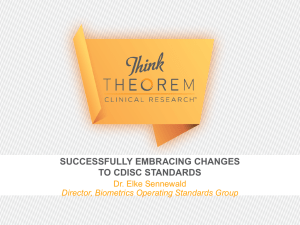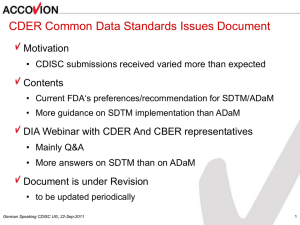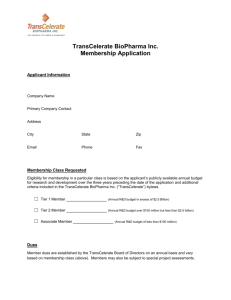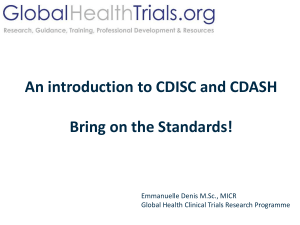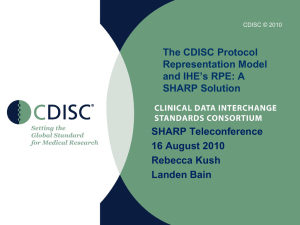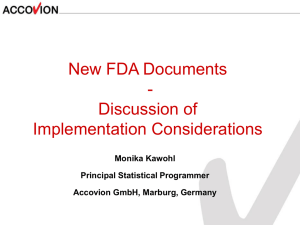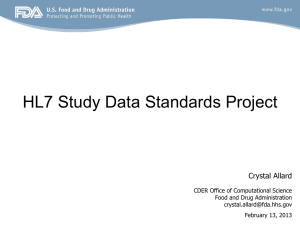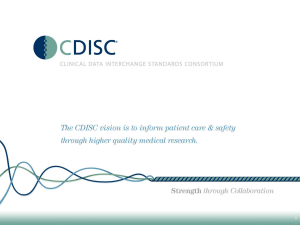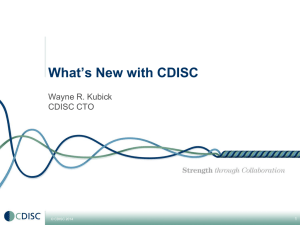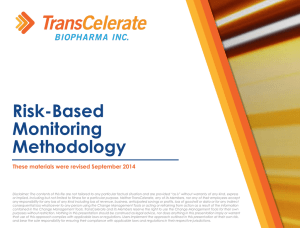Pre-Competitive Collaboration in Clinical Trials
advertisement
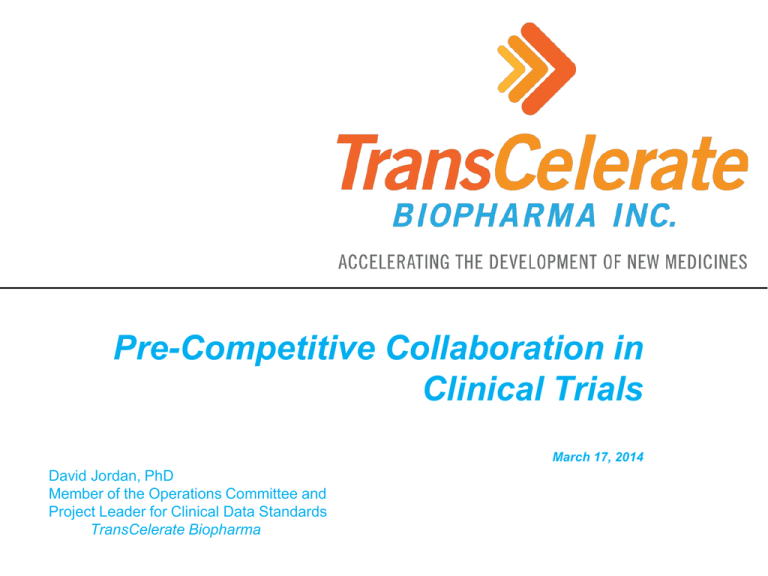
Pre-Competitive Collaboration in Clinical Trials March 17, 2014 David Jordan, PhD Member of the Operations Committee and Project Leader for Clinical Data Standards TransCelerate Biopharma Outline • TransCelerate Overview – Why – Who – What • CFAST Overview • Opportunity for Collaboration 2 Click to edit Master title style Why do we need Pre-Competitive Collaboration in Clinical Trials? 3 Moore’s Law: Transistor Count Doubling Every Two Years Source: Wikipedia 4 Eroom’s Law: Number Of New Drug Approvals Per Billion US Dollars Halved Every Nine Years Source: Nature Reviews – Drug Discovery: Diagnosing the decline in pharmaceutical R&D efficiency Vol 11, March 2012, page 191 - 200 5 Some Causes of Declining Productivity in Drug R&D • Biomedical R&D increasingly complex* • Higher regulatory hurdles * • Challenges too large for individual companies to overcome *Source: Nature Reviews – Drug Discovery: Diagnosing the decline in pharmaceutical R&D efficiency Vol 11, March 2012, page 191 - 200 6 Click to edit Master title style Who is TransCelerate How does it operate? What are its Initiatives? 7 TransCelerate BioPharma - A Response to the Productivity Crisis in Drug Development • TransCelerate launched September 2012 by ten of the largest global Pharmaceutical companies to • advance innovation in drug R&D • identify and solve common R&D challenges • further improve patient safety • Clinical Trial execution identified as a key priority 8 The Charter Members of TransCelerate Include Ten Major Pharmaceutical Companies TBA (Board Member) David Jordan (Operations Committee) Divisional VP, Stats & Data Mgmt Paul Stoffels (Board Member) Worldwide Chairman of J&J Pharmaceuticals Martin Fitchet (Treasurer to the Board, Operations Committee) Chief Operating Officer Briggs Morrison (Board Member) EVP, Global Medicines Development Sue McHale (Operations Committee) Executive Director, Global Project Delivery Jan Lundberg (Board Member) EVP of Science & Technology Jeff Kasher (Operations Committee) VP and COO Global Medical R&D Klaus Dugi (Board Member) Corporate SVP, Medicines Thor Voigt (Operations Committee) Head of Global Clinical Ops, Biometrics & Data Management John Hubbard (Board Member) SVP Development Operations Craig Lipset (Operations Committee) Head of Clinical Innovation Brian Daniels (Board Member) SVP Global Development & Medical Affairs Jonathan Zung (Chairman, Operations Committee) VP, Global Development Operations Reb Tayyabkhan (Operations Committee) Exec. Director, GDO Business Operations Corsee Sanders (Board Member) Global Head of Development Innov. & Clin Ops Carol Harris (Operations Committee) Global Head Project & Functional Excellence Patrick Vallance (Board Member) President, Pharmaceuticals R&D Lynn Marks (Corporate Secretary) SVP, Clinical Platforms & Sciences Pete Milligan (Operations Committee) VP, Clinical Platforms Transformation Elias Zerhouni (Board Member) President of Global R&D Andy Lee (Operations Committee) SVP, Head Global Clinical Operations 9 Nine new member companies joined TransCelerate in 2013 Board Members Peter Carberry (Board Member) SVP & Head of Global Development Operations Nancy Sacco (Operations Committee) Executive Director, Development Sciences/Strategic Alfred Sandrock (Board Member) SVP, Head of Development Sciences & CMO Murray Abramson (Operations Committee) VP, Global Clinical Operations Steve Gilman (Board Member) EVP, R&D and CSO Uschi Stoutenburgh (Operations Committee) Senior Director, Clinical Operations Annalisa Jenkins (Board Chair) Global Head of R&D Kathleen Ford (Operations Committee) Senior VP, Head of Global Clinical Operations Marco Taglietti (Board Member) President, Forest Research Institiute & CMO Ulo Palm (Operations Committee) SVP, Clinical Operations & Biometrics Garry Neil (Board Member) Global Head, R&D Non-Board Members Steve Johnson (Operations Committee) SVP, R&D Business Services Gareth Morgan (Operations Committee) SVP, Portfolio Management, Global Development Office Brigitte Koch (Operations Committee) VP, Head Global Clinical Project Management 10 Delivery Strategy A Team flat organization Structure structure has been developed to manage projects and operational activities Board of Directors External Counsel Accounting Firm Audit Firm Administrative Asst. Sub-Committees CEO Clinical Operations Committee Director of Operations Director of Projects Finance Lead Initial Workstreams Change Management Data Standards Risk Based Monitoring Communications Site Qualif. & Training Comparators Network Regulatory Head of Delivery Excellence & Corp Affairs Investigator Collaboration Platform New Workstreams Investigator Registry Common Protocol Template Special Populations Network Exploratory Project 1 Exploratory Project 2 Exploratory Project 3 Technology Redacted CSR Future Initiatives Planning Retained Position Confidential - NOT FOR DISTRIBUTION Contracted Resources Key: Member Representatives 11 Not for profit entity created to drive collaboration as means to developing solutions for overcoming inefficiencies Our vision To improve the health of people around the world by accelerating and simplifying the research and development of innovative new therapies. Our mission To collaborate across the global research and development community to identify, prioritize, design and implement solutions that drive the efficient, effective and high quality delivery of innovative new therapies. Our core values • • • • • Quality Transparency & Openness Trust & Integrity Collaboration Courage 12 An Entity that Engages with the Wider Clinical Ecosystem Globally Strategically focusing engagement efforts with selected key stakeholder groups The intent is not to recreate, but partner whenever feasible Industry Initiatives Investigative sites Regulatory Bodies Confidential - NOT FOR DISTRIBUTION Research and CRO Community 13 Ongoing Initiatives – progress (1 of 3) Five Selected Areas of Focus Have the Shared Goals of Increased Quality, Patient Safety and Accelerated Development Timelines Initiative Objective Benefit Clinical Data Standards – Efficacy (in Partnership with CDISC and CFAST) Accelerate current efforts underway through CDISC to establish efficacy data standards Comparator Drugs for Clinical Trials Establish a supply model • Reduce the cost and effort for comparator to source comparator drug sourcing drugs between • Reduce the chance of companies for use in counterfeit drug in study clinical trials supply chain • Share critical data – like solid dose ambient temp excursions • Progress to date Increased quality of clinical • Partnered with CDISC, Critical Path Institute, FDA data and enablement of and NCI on CFAST Therapeutic Area Program industry end-to-end data Steering Committee flow • Asthma, Diabetes, Cardiovascular endpoints, QT studies, Multiple Sclerosis, Hepatitis C and Traumatic Brain Injury selected as first TAs of focus • Approved Breast Cancer, Influenza, Lipid-Lowering, COPD, CV Imaging, MDD, RA, Psoriasis & Schizophrenia project proposals • SHARE environment (metadata repository) press release issued with CDISC in June 2013; SHARE R1 Release went live Jan 31 2014 • Asthma Therapeutic Area User Guide V1.0 published Nov 27 • Determined in-scope products and required documentation for distribution model • Defined principles and process for drug distribution model • MSA’s between members finalized • First set of transactions initiated in July 2013 • Press release issued in August 2013 • Multiple transactions continue to occur and direct benefits being realized • Expansion of network activities for 2014 14 Ongoing Initiatives – progress (2 of 3) Five Selected Areas of Focus Have the Shared Goals of Increased Quality, Patient Safety and Accelerated Development Timelines Initiative Objective Benefit Progress to date Model Approach for High-Quality, Risk-Based Monitoring Develop an industry framework for targeted, risk based clinical trial monitoring • Improvement in data quality and patient safety for clinical trials • Reduction in effort expended on lowvalue activities • FDA and EMA feedback incorporated • Position paper and methodology published in May 2013 for access to entire clinical trial community; Shared Site Qualification and Training Mutual recognition of GCP training between pharmaceutical companies and streamlining site qualification process • Improved quality of clinical sites and accelerated study start-up times • Reduce site burden • Team formed to streamline site documentation • Establishment of framework for mutual recognition of GCP training completed Update to the paper and associated training materials published in January 2014 • More than 30 pilots identified and launched with 8 of these reviewed by FDA prior to initiation • Over 2000 unique downloads of position paper • Conducted FDA orientation for the TransCelerate RBM methodology Minimum content elements Process for awarding certificates Process for training providers to self attest to minimum criteria/courses • Mutual recognition framework established • Created and published to TransCelerate website: CV and Site Profile Documents and Guidance Guidance for completion of FDA document 1571/72 Guidance and Delegation of Responsibility form • Planning for PI Oversight Training and Training for Sites Less Experienced with Clinical Trials 15 Ongoing Initiatives – progress (3 of 3) Five Selected Areas of Focus Have the Shared Goals of Increased Quality, Patient Safety and Accelerated Development Timelines Initiative Objective Benefit Progress to date Shared Site Collaboration Platform Establish a single, intuitive interface for investigators, regulators and member companies • Ease of use and harmonized retrieval of content and services for investigators • Reduce site burden • Reduce member company costs • Defined components to leverage from existing industry portals • Board approval for analysis phase in June • Systems integrator, product partner and hosting partner selected • Early adopters of system confirmed (formerly Common Investigator Site Portal) 16 The future - a roadmap was created with the future state in mind Approved TransCelerate projects Future State Current State • Disconnected interfaces • Manual processes and interventions • • Limited standardized processes Ongoing projects Data Standards Risk Based Monitoring Comparator Network (ES) Site Qualification and Training (ES) Collaborative Technology Platform Lot of customization • Rework • Variable quality • Wait time • Missing information • High costs • Long cycle times • Duplication of efforts New projects for 2014 Data Transparency/CSR Redaction* Common Protocol Template Investigator Registry Clinical Trial Networks Pediatric patients Minority patients Exploratory projects for 2014 Exploratory project I Exploratory project II Exploratory project III (ES) – Expanded Scope for 2014 * Workstream initiated to meet compliance deadline • Patient-centric clinical trial design • End-to-end electronic data flow • Seamless interfaces • Automated • Transparent • Increased standardized processes • Less rework • Quality by design • Shorter cycle times • Cost efficient • Integration of Regulatory, Safety and Medical Sciences • Elimination of redundancies • Conducting clinical trials together • “Colossal Data Analytics” 17 New Initiatives (1 of 2) Three New Initiatives Will Further Support the Goals of Increased Quality, Patient Safety and Accelerated Development Timelines Initiative Unmet Need Description Benefit Common Protocol Template • Format of study protocols vary from company to company making interpretation difficult for study sites, IRBs, and regulators. Standardize the format of clinical protocols to ease interpretation & enable downstream automation of many clinical processes. Develop industry-wide & regulator accepted standards for required protocol endpoints • Higher productivity of sponsors, sites, IRBs, and regulators • Study protocols have become increasingly complex as no agreed upon standards exists driving up cost and time. • Manual set-up of clinical systems based on nonstandard “manual” protocols are time consuming, costly, and prone to error • Less costly and time consuming clinical trials • Enabler for downstream automated setup of clinical and operational systems & disclosure activities New Initiatives (2 of 2) Three New Initiatives Will Further Support the Goals of Increased Quality, Patient Safety and Accelerated Development Timelines Initiative Unmet Need Description Benefit Investigator Registry Sponsors invest significant time and money in identifying qualified investigators and setting up study sites To create a shared repository of investigators to support targeted patient selection Reduced cost and time of setting-up and running clinical trials Special Populations Clinical Trial Networks (minority & pediatrics) • Qualified investigators with adequate study patients are difficult to find for special populations – e.g. pediatric and minority Lead the development of global investigator networks for pediatric and minority populations including governance, investigator and patient registries, and technical infrastructure • Faster development of new drugs in both pediatric and minority populations • Studies in minorities and pediatrics are costly and lengthy • Efforts are put into repeatedly establishing a network for a single study only to disperse the network after study completion • Reduced costs of pediatric and minority trials Summary • Drug Development is facing a productivity crisis • TransCelerate BioPharma Inc. has been founded to address aspects of this issue • A number of critical initiatives are ongoing or will start to improve the clinical trial process in key areas 20 Outline • TransCelerate Overview • CFAST Overview – Therapeutic Area Data Standards Organization – TA Data Standards Projects • Opportunity for Collaboration – BRIDG: The Biomedical Research Integrated Domain Group (BRIDG) Model – SHARE: The CDISC Shared Health And Clinical Research Electronic Library (CDISC SHARE) 21 Coalition For Accelerating Standards & Therapies -- CFAST •CFAST - an initiative to accelerate clinical research and medical product development by creating and maintaining data standards, tools and methods for conducting research in therapeutic areas that are important to public health •An Objective - Identify common standards for representing clinical data for studies of drug products in specific, prioritized therapeutic areas [TA] •To be implemented using CDISC structures (CDASH, SDTM) •Support integration of clinical data from disparate sources as a foundation for end-to-end data flow 22 Project Organization CDISC Standards Review Council CDISC Chief Technology Officer CFAST Therapeutic Standards Steering Committee CDASH Team SDS Team Questionnaires Team Project Manager Program Manager Therapeutic Area Clinical Experts Process Expert Consultant Concept Creators Collaborates ADaM Team Terminology Teams Other CDISC Teams Statistical Analysis Experts CDISC Team Liaisons CFAST Scientific Advisory Committee SDTM Expert Consultant Terminology Expert Consultants BRIDG Expert Consultants Technical Writer CFAST Governance CDISC Teams Program Resource Project Resource Review Community: CDISC, C-Path, FDA, TransCelerate BioPharma, Key Opinion Leaders, Medical Associations, U.S. National Institutes of Health, Innovative Medicines Initiative 23 CFAST TA Data Standards Development 2013 List of Projects 1. Asthma v1.0 - completed Nov 2013 2. Alzheimer’s Disease v2.0 – completed Dec 2013 3. Multiple Sclerosis 4. Diabetes in adults 5. Cardiovascular Endpoints 6. QT Studies 7. Traumatic Brain Injury 8. Virology – Hepatitis C 24 CFAST TA Data Standards Development 2014 Partial List of Projects 1. Oncology – Breast Cancer 2. Schizophrenia 3. Influenza 4. Lipid-Lowering 5. Rheumatoid Arthritis 6. Major Depressive Disorder (MDD) 7. Cardiovascular Imaging (echo) 8. COPD 9. tbd 10. tbd 11. tbd 12. tbd See http://www.cdisc.org/therapeutic for more information 25 TA Standards: Baseline Content • Mindmap/model of disease area clinical concepts • Essential core data elements with definitions, data types (simple & ISO 21090), BRIDG and SDTM mappings • SDTM domains and examples • Minimum value sets (code lists) with definitions and c-codes • User/Implementation Guide with permissions statement • Standard CDASH CRFs with SDTM annotations, as appropriate • ADaM Analysis model examples as available • Possibly study design models 26 Outline • TransCelerate Overview • CFAST Overview • Opportunity for Collaboration 27 Click to edit Master title style What are opportunities for collaboration ? 28 Contact Points within TransCelerate • Clinical Data Standards •David Jordan david.jordan@abbvie.com •Rhonda Facile (CDISC) rfacile@cdisc.org • Comparator Drugs for Clinical Trials - Terry Walsh terry.walsh@transceleratebiopharmainc.com • Risk Based Monitoring - Reb Tayyabkhan rehbar.tayyabkhan@bms.com • Shared Site Qualification and Training •Sue McHale susan.mchale@astrazeneca.com •Katarina Hugeneck hugeneck_katarina@lilly.com • Shared Site Collaboration Platform - Jackie Kent • Common Protocol Template - Rob DiCicco • Investigator Registry - Bill Jordan william.jordan@sanofi.com • Special Populations Clinical Trial Networks - Susannah Hammond susannah.3.hammond@gsk.com kent_jacalyn_m@lilly.com robert.a.DiCicco@gsk.com 29 i/p = In progress n/a = Not applicable dft = Drafted = completed ? = not sure who / status CDISC, PhUSE Safety Standards Domains Collected (CDASH) Observed (SDTM) Analysis (ADaM) Reporting (TFL) Adverse Events i/p Comments n/a n/a Concomitant Medications Deaths (AE) ? ? i/p i/p Demographics ? i/p Disposition ? i/p ECG Test Results ? dft Exposure n/a n/a n/a ? i/p Laboratory Data ? dft Medical History ? i/p Pharmacokinetics (lab, exposure?) ? i/p Subject Visits n/a n/a Vital Signs ? dft Topics Hepatotoxicity (central lab) Adapted from Scott Getzin 30 Therapeutic Area Standards (Defined) Observed (SDTM) Analysis (ADaM) ? Reporting (TFL) ? Pain v1 ? ? Parkinson's Disease v1 ? ? Polycystic Kidney Disease v1 ? ? Tuberculosis v1 ? ? Virology v1 ? ? Asthma v1 - ? Alzheimer’s Disease v2.0 ? ? Multiple Sclerosis i/p ? ? Diabetes in adults i/p i/p i/p Cardiovascular Endpoints i/p ? ? QT studies i/p i/p ? Hepatitis C i/p i/p ? Etc., Etc. i/p ? ? Topics Alzheimer's Disease v1 Adapted from Scott Getzin 31 Alignment of Clinical Data Flow Clinical Data Flow Industry Standards Alignment Trial Design Data Collection Systems Observed Datasets Analysis Datasets PRM CDASH SDTM ADaM Tables, Figures and Listings No/Few TFL Stds Exist ? Courtesy of Scott Getzin 32 Questions? 33
